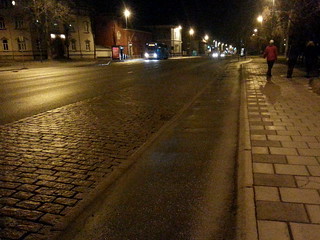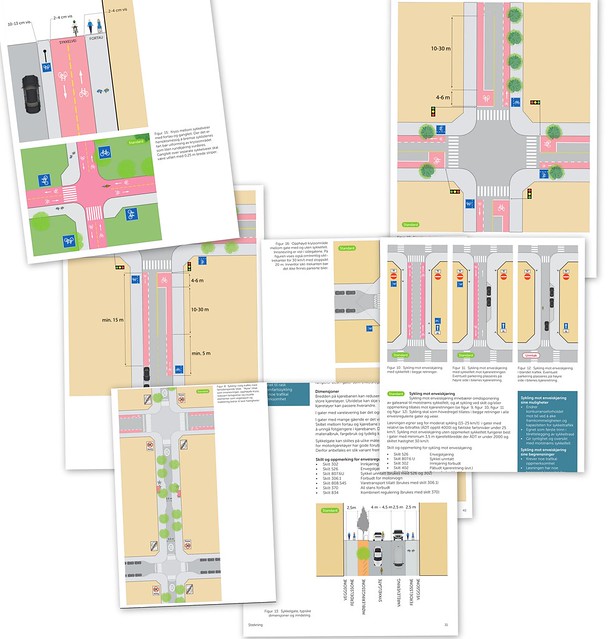
So there you are. A capital city in a European country wanting desperately to keep up with the cool kids. Wanting to improve city life, generally, but also focusing intensely on re-creating a bicycle-friendly city.
Oslo has grand plans. The news in October 2015 that the city council had voted to make the city centre free of private cars by 2019 - as well as many other plans - was a shot heard round the world and captured imaginations in many other cities.
The City of Oslo is gearing up for change, no doubt about it. At Copenhagenize Design Company, we’ve gone so far as to call the city “the next big thing” in bicycle urbanism. There are more people employed to make the city bicycle-friendly in Oslo than in almost any other city on the planet. Sure, they’re divided up in different, confusing departments, but they’re there. A group of vaguely focused landscape architect types in the city’s Bymiljøetaten (Agency of City Environment) and the City’s temporary Sykkelprojsektet - or Bicycle Agency - who are tasked with implementing the city’s bicycle strategy.
It is the latter who are orchestrating the show and who have a clear understanding of what is needed and how to do it. Yesterday, The Bicycle Agency released a long-awaited document clearly outlining their roadmap for bicycle infrastructure in the city. It is one of the most interesting and inspiring documents we’ve seen coming out of a municipality anywhere in the world.
The Oslo Standard. Remember that name.
All good, right? Off they go, you might think. Political will, money, loads of people ready to work. Unfortunately, it turns out that it’s not that easy. Which is exactly why The Oslo Standard for Bicycle Planning now exists. It is available in a public hearing version, in Norwegian, but an English version will be out later in the year.
Like many places, Oslo and other cities in Norway are under the thumb of a Road Directorate and the nature of such organisations is to be slow to change, keep a firm grip on outdated traffic engineering principles and generally be a pain in the ass of people who see a better vision for our cities.
Like many places, Norway has road design standards dictated by said road directorate. Traffic engineers would have you believe they are carved in stone and are second only to the Ten Commandments in their worth. Oslo, however, has fired up their jackhammer.
The Norwegian road design standards are, quite simply, the biggest hurdle to The Bicycle Agency implementing the City’s bicycle strategy. They are hopelessly outdated and include little in the way of modern, Best Practice bicycle infrastructure design.
It’s not a new story. In 2012, the National Transport Ministry was tired of getting the same old, same old answers from the Road Directorate and chose instead to ask someone new. Together with Civitas, Copenhagenize Design Company produced a huge feasibility study to help boost cycling in Norwegian cities. The report basically recommended Best Practice infrastructure across the board.

Norway and Oslo are no stranger to Best Practice. Aftenposten newspaper, in 1941, wrote about “Oslo’s First Bike Lane”, which was clearly inspired by Copenhagen. Indeed, a separated cycle track is called in professional circles a “dansk sykkelsti” - Danish Bike Lane.

You can see examples in the country’s best city for urban cycling, Trondheim, put in in the 90s. A bit narrow, but hey. Best Practice, at least. Ironically, bizarrely and sadly, the Road Directorate removed these designs from their standards.
This is where The Oslo Standard comes in. It is Oslo’s own standard for bicycle infrastructure design and it includes Best Practice solutions that are not included in the national road standards. The “dansk sykkelsti” is called “raised bicycle area”, in order to establish it in a new context.
This is Oslo saying, “If you won’t modernise, we’ll do it on our own”.
And they are. They have presented a clear vision for bicycle infrastructure design with their Oslo Standard and they are fine with stepping on the toes of the national road directorate. It is a planning document, but it is also a shot fired across the bow signalling a sea change in how Oslo wants to plan its streets for transport in the future. It has clear political signals, as well. Shoving is the new nudging. Shoving the road directorate into the new century.
Here is the introduction to the document:
The Oslo Standard for Bicycle Planning is one of the main initiatives in the City’s bicycle strategy. It translates the city’s goals for bicycle modal share, sense of safety, accessibility and traffic safety for cyclists into practical solutions for building bicycle infrastructure. Norway’s national bicycle strategy 2014-2023 includes a goal that 8% of all trips must be done by bike. This would mean that the modal share for bicycles in cities must be between 10-20%. The Bicycle Strategy for Oslo 2015-2025 has a declared goal that 16% of all weekday trips will be by bike before 2025. In 2013, the modal share was measured to be 8%.
In a comprehensive study in 2013, a majority of Oslo’s citizens say they don’t feel safe cycling in the city and that much of the bicycle infrastructure that is in place doesn’t satisfy the citizens’ needs or wishes. As the country’s capital, Oslo must lead by prioritising pedestrians and cyclists and use solutions that make it possible to reach both national and municipal cycling goals.
Clear, defined and with a “we’re going it alone” attitude. Refreshing.
Compared with similar, strategic documents, The Oslo Standard wholeheartedly embraces Best Practice. The American NACTO guide, for example, has some good stuff but it also includes leftovers of designs that were chucked out of Danish Best Practice two decades ago and it has an awkward, American engineering feel to it, even though it hopes to be a counterweight to the ASHTO guide. The Oslo Standard, however, nails it. They have done their research.

Here you can see a selection of screen grabs of the infrastructure designs. Reading through the document we were pleased to see that bidirectional infrastructure is reserved for off-street areas and stretches without many intersections to avoid conflicts. Here is why THAT is important.

All manner of designs are included, featuring every street typology possible in the city of Oslo and, indeed, in most cities on the planet. Lots of inspiration from Danish Best Practice and some from Holland. Oslo is clear on their focus. No sub-standard solutions. Certainly no center-running lanes, that's for sure.

While cycle tracks are the default, there are still plans for painted lanes - causing shivers down the spine of any professional bicycle planner worth their salt - but as long as we know that they GET IT and want to do the proper design where possible, we can let it slide just a little. They know that bike lanes should be along the sidewalk and NOT inbetween the door zone in a single-occupant vehicle society and moving traffic. So that helps us sleep at night.
While Oslo can muscle on and plans their streets with modern designs in the Oslo Standard, the road directorate still dictates signage. Which proves to be rather comical.

This isn't Norway in the photo but it's a pretty close to what the situation looks like when the road directorate are in charge.
So that is something that needs to be worked on. Then there is the bizarre bureaucracy inherent in the Oslo municipality.
But a foundation has been laid in Oslo. A vision is ready to be made into a reality. The Oslo Standard is the new darling for bicycle urbanism.
Let's hope that they can translate their vision into asphalt and boost transport in Oslo into the 21st century